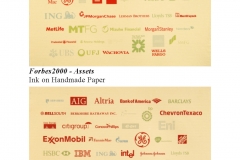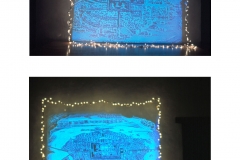Cartographies: Mapping Intersections & Counterpoints
Curator’s Statement:
Karen Oremus, Assistant Dean, Department of Art and Design, Zayed University, UAE
Catherine Bebout, Associate Professor and Head of Printmaking, Paper & Book Arts, Montclair State University, USA
Maps have been an integral part of weaving a narrative amid the history of human exploration, development, and technology. As systems of organization, they not only function to calculate distance and geographical boundaries, but also to depict a record of histories both real and imagined. Mapmaking was a consequence our desire for information fueling on the one hand consumption, while on the other, satisfying needs for power and discovery through the conquering distant lands. Through illustrations tucked within the marginalia areas of maps, the early cartographer’s revealed a multitude of perceptions that impacted not only cultural attitudes of the times but created stereotypes that still persist today.
As curators, these ideas presented conceptually fertile ground not only for the topic but also works selected for this exhibition titled, “Cartographies: Mapping Intersections & Counterpoints.” The images chosen are intended to deepen the viewer’s experience as well as open perceptions to allow for the discussion regarding displacement, religion, politics, and cultural attitudes.
In the video projection series titled, “Currents,” Janet Bellotto overlays ancient maps of Mexico City with dust travels in a room and overlaid with sound of the infamous poet Sister Juana, who traces the space in a visual language. Documenting thousands of hours photocopying microfilm and downloading headlines from the Internet, A. J. Bocchino’s reproduces charts that allude to our collective memory and how it shapes cultural identities. The artists Catherine Bebout, Alicia Candiani, and Deborah Cornell visually discern the connection of mapping to the human body from multiple perspectives. In Bebout’s work, sacred charts, diagrams, patterns in nature and science are investigated to reveal connections between evolution and the universal rhythms of life. Candiani juxtaposes the politics of the female body with the social roles or cultural expectations of Latina women. Deborah Cornell’s work is motivated by the grandeur and questions of science and how the exactness of living forms is currently being transformed through research and genetics. The pixelated maps of Banu Colak enable the viewer to deconstruct concepts of home versus transnational communities and through a multi-layered reading, encompass the political issues within.
Recurring questions for artist Paul Coldwell is how new technologies impact and manipulate space and scale relationships. In relation to the small personal artifacts or objects selected for the series, ‘Case Studies’ he uses mapping devices like trace points to connect image to landscape. In the mixed media work of Todd DeVriese, the artist addresses the challenges of history, mythologies, culture and social issues and is an investigation of how historical events have shaped the present apart from arrive at new sets of understandings. Matthew Dols describes his work a “sense of place” and infinitely more than a representation of facts and figures as it spans time, memory, and emotions.
Kip Deeds “Alasktic” print series take the viewer on a journey from Mexico to Alaska through the eyes of this Philadelphian artist. The “Alasktic” project was inspired by Utagawa Hiroshige’s 1834 print series, “53 Stations on the Tokaido,” which depicts scenes along the famous eastern sea road in Japan and stylistically borrows from other depictions of travel in the United States. The concept of journey is also employed in the “Emerging Cartographies” imagery of Alison Hildreth. These series are visual maps of investigations through divided cities, natural and manmade terrains and are inspired as much by reading as an empirical observation of the landscape. In “The Map Room,” Lori Nix photographic images and videos are constructed from tiny dioramas she builds to depict dystopian worlds. The conversation in Naz Shahrokh’s “Artist Palette Series,” concerns the process of making objects through collected parts; both in the active collection of materials throughout the journeys and travels, as well as seeking particular materials to convey a personal meaning of a place and time. Incorporating various media, Marco Sosa merges physical and ephemeral- intersecting realities separated by time and space in his projection installation titled, Mapping Non-accidental Intersections. Karen Oremus’s work utilizes map imagery to signify ‘place’ and ‘distance’, demonstrating both the physical and mental distance between herself and mother who struggled for several years with Alzheimer’s disease.
Living in today’s increasingly global society, our existence is often being defined as hyphenated identities as well as a sense of displacement. Just as countries continuously reinforce or reshape their national and international images, so do artists who struggle with their own identities in our changing, shrinking world. Akin to the early cartographers, this exhibition addresses the fluid nature of maps as pictorial bridges or crossing points emerging from a manifold of associative viewpoints and conceptual ideas. The intent is to present our viewers with a collaborative atlas of metaphoric associations and discovery through each of the artists represented.




















